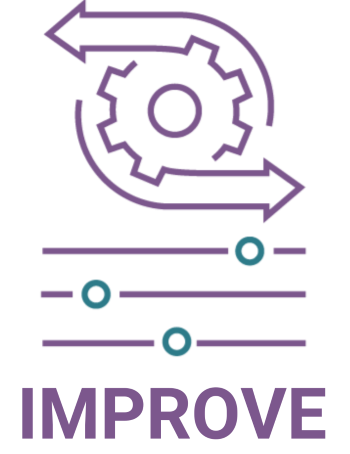7 Ways Insurers Can Overcome Innovation Resistance
An insurer decides to adopt a new underwriting solution that harnesses the power of machine learning. The executive team is super excited about the potential for greater profitability. They are a transparent company so they announce the decision immediately, with great enthusiasm.
What happened next? Something different than they expected.
Team members responded negatively and raised a multitude of concerns. Instead of being receptive to change, they actively lobbied to reject innovation.
The company’s leaders were shocked. They never anticipated resistance, but they probably should have. In fact, rapid technological advancements trigger an instinctual fear of the unknown for many people. To gain the advantages of early adoption, businesses need to purposefully overcome innovation resistance.
The Fear of the Unknown
People resist what they don’t understand. This common aspect of human nature influences all aspects of life, including work. On the flip side, people tend to find comfort in the familiar. Whereas this may be a good thing when it comes to things like family traditions, it may be a barrier to technological innovation and progress.
Your team members may feel that, since the old way of doing things worked in the past, there’s no reason to do anything differently now. They may be uncomfortable at the thought of having to learn new skills or afraid of the impact new technology will have on their careers.
A survey from Ernst & Young found that 75% of employees worry AI will make certain jobs obsolete and 65% worry their jobs will be on the cutting board. Anxiety levels have gone into overdrive with the onslaught of new generative AI tools – 48% of respondents said they are more concerned about AI now than they were a year ago and 41% think the technology is evolving too quickly.
Unfortunately, fear of AI may hold companies back. According to Accenture, the technology leaders are growing revenues twice as fast as the technology laggards.
As technology improves, the gap between the leaders and the laggards will only increase. Right now, businesses have the chance to gain a competitive advantage as early adopters of innovation. However, before that’s possible, they need to get their team members on board. There are a seven ways to do that.
1. Think Through Your Communication Rollout
Before you announce anything, think carefully about what your team members need to know and when it’s important that they know it. Don’t feel compelled to overwhelm your team with everything at once. Make a list of the functions whose jobs intersect with the new technology, and list the possible concerns that could come up. Some of these concerns may be valid – not just fear-based. Take time to think through all the ramifications, so you can anticipate and address potential concerns up front. If possible, prepare the following:
A demo or proof of concept so team members can see, firsthand, how the technology works.
A workflow diagram so team members can visualize the new process.
A sheet of Frequently Asked Questions that addresses all the potential concerns.
Talking points and concern management processes for supervisors.
2. Engage Managers and Team Leaders First
When your managers and team leaders are apprehensive about new technology, the fear may trickle down to the rest of the team. As a result, workers may resist using new tools, which will slow down progress.
To prevent this from happening, it’s important to get leaders on board first. Bear in mind, they may be experiencing many of the same fears as other workers. Invite them to participate on your transition team and invite their concerns. This will provide invaluable input about questions that other team members may have as well. When possible, assign transitional tasks to supervisors to get them engaged in the process. For example, have them help draft the FAQs or think through the best way to revamp a workflow or reallocate responsibilities.
3. Consider Timing
Ideally, you want to communicate the move after the proof of concept is complete. This will enable you to share a full picture of why you decided to move forward. It’s best to communicate the change verbally – either in-person or via video with one well-respected person – preferably someone involved with the function the change is affecting. For example, if the change involves underwriting, an underwriting leader should be the spokesperson.
If you’re communicating in-person, choose a day when most employees are present and videotape the conversation for anyone not present.
Prepare your supervisors and managers with talking points and processes to help them manage concerns from their team.
4. Highlight the Benefits for Team Members
When communicating change, keep your audience in mind, and always focus on what’s in it for them.
Although people are afraid of being displaced by AI, many are also burned out and overworked. In a survey from Microsoft, 70% of people said they would delegate as much of their work as possible to AI to decrease their workloads.
If leaders can frame new technology as beneficial for individual workers, those workers might get on board. On the other hand, if leaders only talk about the benefits for the company, the individual workers may worry they’ll be left out.
For example, underwriters may be wary of machine learning and AI tools if they think the company will lay off workers, but those same underwriters may be eager to adopt machine learning and AI tools if they believe the tools will make their jobs more enjoyable by reducing tedious tasks and boosting accuracy.
5. Use A Controlled Forum for Managing Updates and Questions
To manage ongoing communication updates and questions, consider establishing a password-protected web page where you can post FAQs, rollout timelines and important information. Be mindful that information on a web page could be copied or shared, so keep confidentiality in mind as you determine which types of content to post. Consider creating an email address where employees can submit questions, ideas and concerns. This helps ensure that all team members can be heard. It may also help identify potential issues you haven’t yet considered.
6. Help Workers Gain New Skills & Focus on the Future
In some cases, workers are less worried about being replaced by technology than they are about being replaced by more tech-savvy workers. This fear is widespread – Ernst & Young found that 67% of workers are worried they’ll lose out on promotions for not knowing how to use AI tools.
Employers can help by providing training and reskilling opportunities. Indeed, this may be a win-win approach: employees benefit because they learn new skills that help them do their jobs better while alleviating their fear of becoming obsolete, whereas companies benefit from having a tech-savvy workforce.
If workers know what they will be doing in the future instead of what they used to be doing in the past, they can relax and focus on the next phase.
7. Share the Greater Good
In addition to helping team members understand the personal benefits of change, be sure your team understands the big picture. Let them know:

How the solution could help your company grow and expand, creating more advancement opportunities.

How the solution improves the policyholder experience.

How the solution achieves a purposeful goal like reducing bias and making coverage more accessible, for example.
The Fear of the Unknown
Technological innovation has always sparked resistance, whether the technology in question is modern factories, word processors, or AI. This is nothing new, but today’s rapid pace of progress makes it a critical issue right now. By being transparent about your company’s AI adoption and taking purposeful steps to help your team feel comfortable, you will reduce innovation resistance, which will allow your company to gain the advantages of early adoption.
About Soteris
Soteris leverages machine learning to improve auto insurance risk selection. We work collaboratively with our clients to smoothly roll out thoughtful and well-tested risk selection processes. The Soteris SaaS solution runs alongside existing systems with existing rate filings so insurers can get started in four months with no rip and replace.




